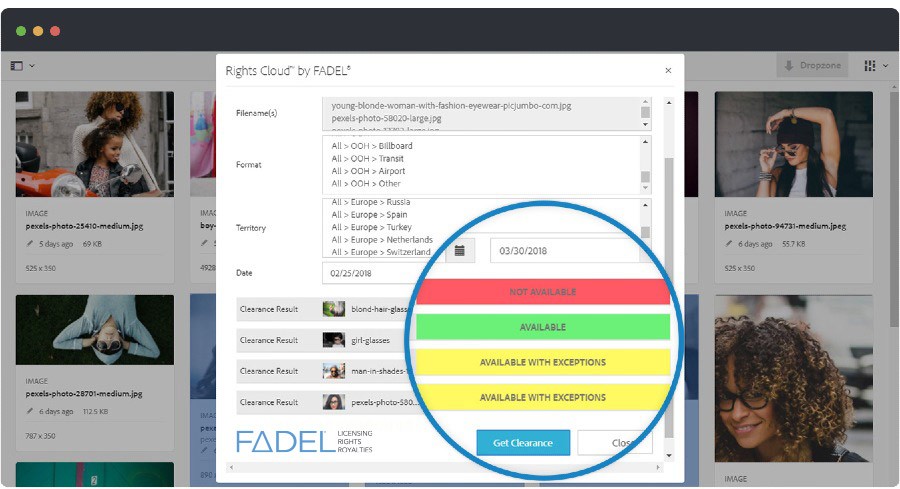Boost Efficiency and Compliance with Role-Driven DAM
Digital assets are touched by many roles across your ecosystem for different purposes. If you really want to maximize the value of your DAM and the value that’s locked in your assets, you need to empower all users with purpose-driven tools and integrated intellectual property management software.
Depending on their responsibilities, users may acquire, manage, enrich, consume, or just view assets. By identifying the key roles in your organization that interact with digital assets and the features and functionality each one needs to focus on their job at hand, you’ll be able to increase efficiency by better distributing work across teams, enable a consistent workflow with more streamlined processes and increased productivity, and bring your campaigns to market quicker and more efficiently–all while enforcing compliance throughout the marketing lifecycle.
Defining Roles & Responsibilities
When we take a look across the content lifecycle, there are many roles that may need access to your DAM, media asset management software, and rights management software for various reasons. Role titles and responsibilities vary from company to company, so for the purposes of this article, we have condensed them into five umbrella roles:
- Marketing management and operations may include brand managers, marketing planners, and product owners.
- Content creators could be designers, agencies, producers, and photographers.
- Rights managers could be the legal team or librarian.
- Content consumers may be your internal team, agencies, and even customers.
- Compliance officers could be talent managers, brand managers, or the legal team.
Once you have a clear idea of who is using the DAM to get their jobs done, you’ll want to understand what type of information they’re seeking/providing, where they need to go to access it, when during the marketing lifecycle they play a role, and how they are leveraging the DAM. This provides the foundational information you’ll need to provision users and create a collaborative and efficient digital environment where each role has access to exactly what they need. Another benefit is that establishing user access rules and restrictions provides the right level of security.
Selecting the Right Tools for the Job
There are a lot of tools in the DAM toolbox, and even more when you take a holistic look at your MarTech stack. When it comes to digital assets, your marketing team and various partners may use these applications to:
- capture extensive metadata including custom data, rights, and standardized information;
- filter and share assets using sophisticated search tools;
- support digital rights management (DRM), including negotiating and handling complex talent and agreement scenarios;
- track asset requests, distribution, usage, and performance;
- generate expiration and violation reporting for brand compliance; and monitor brand products, logos, spokespersons, and media content for in-licensing.
Roles / Jobs to be Done
A good way to think through roles is to outline them in terms of “jobs to be done”, starting at the very beginning of the marketing lifecycle, with ideation for a marketing campaign. This would entail defining assets and talent needed and negotiating the rights and terms of usage, and might be done by marketing operations, brand managers, or product owners.
Once those plans are in place and talent is lined up, the content creators, which could be in-house designers, agencies, or producers, step in to create assets, photos, and videos that will be used to support the campaign. These people may then be responsible for submitting the content into the DAM, or this may fall to another role, for example a rights manager, who has knowledge of the rights information related to the content that needs to accompany each asset. It is important to gather the rights up front so you can start using the assets and using them properly right away.”
Once you have the content created, entered into the DAM, and the rights management component in place, content consumers need access to the DAM to pull assets and create the campaign elements. These could be in-house designers, agencies that are accessing your DAM via a portal, or customers. And once they have downloaded the content they need, you want to be able to track and understand where it is all being used. This could fall to a compliance officer, brand manager, or the legal team.
As you can see, as you work through negotiations, production, managing clearance and distribution, and post-distribution tracking, there are different roles that play a part. However, enabling compliance is a commonality that you see across every role in the marketing lifecycle.
Features & Functionality by Role
Marketing Operations
The marketing operations role is typically responsible for lining things up at the beginning of a campaign, and would need tools for hiring talent, for example photographers and models, negotiating their agreements, and capturing releases or procuring licensing. This needs to be organized in a way that makes it trackable so that high-performing assets can be repurposed and agreements can be amended to extend the value of the asset into different geographies, media channels, or timeframes.
The functionality required here would be the ability to set up a campaign, then set up different projects within that campaign, for example a photo shoot, and assign details like date and location. This role would also need access to a talent directory to source a photographer and see what types of agreements are in place as far as pricing and usage rights, then save those details to the campaign. So, in order to do their job, the only functionality this marketing operations person needs access to is the tools to set up the campaign, set up the project, find talent, do a deal with them, and capture that agreement—nothing more. Then, they hand the baton off to the next role in the marketing lifecycle, the content creator.
Content Creator
The content creator will need the tools to take the assets created at the photo shoot, ingest them into the DAM, and make them available to content consumers. This includes tagging them with metadata, organizing them, grouping them, possibly resizing or cropping them, viewing them, and granting access to the people who will use the assets to design and produce the campaign content. However, the content creator would not need access to the agreements and parties that the marketing operations role had access to, because it is not needed for their job.
Rights Manager
Next, the rights manager role takes over. They would need the functionality to manage the agreement rights as they change over time, manage expiration dates, provide answers on clearance, generate usage reports, and ensure the rights remain tied to the assets they belong to. This functionality is more focused on the rights, clearance, and terms data associated with the content rather than the content itself—so, again, a different view from the content creator, however some of the functionality may overlap with marketing operations’ role.
Content Consumer
Once the rights are tied to the assets and made visible, they are ready to be accessed by the content consumers. They will need the functionality to search for and filter assets, group them, add them to a lightbox, share them, run a rights check, and lay them out. Visual search in addition to text search is a handy feature for content consumers, as is the ability to clear assets for all intended uses, e.g., ‘I want to run this campaign in Europe, North America, and South America, and I want to run it on broadcast, digital, print, and social media.’

This is really where you can see the whole flow coming together, from marketing operations, who captured this data in the first place; to the content creator, who created the assets in the DAM; to the rights manager, who associated the rights; to the content consumer, who is pulling assets for use in the campaign.
Compliance Officer
There is also a job to be done post-publication that needs different features and functionality. Tracking assets to make sure they haven’t expired or aren’t being used in a location where you don’t have the rights is key to compliance. This could fall to a compliance officer, who has a completely different view that allows them to track multiple website and social media channels, match assets to those in the DAM, verify that they are cleared for use, report on violations, and take down assets that aren’t in compliance.
Tying it All Together
Many organizations are working across multiple systems to build and execute on their marketing campaigns, so it is important to think through how the architecture is integrated, not just technologically but functionally. This is the key to brand compliance. Everybody has some aspect of their role that ties to brand compliance, whether it’s from a legal perspective, financial perspective, brand protection perspective, or governance perspective. For this reason, thinking about brand compliance in role-driven terms ensures all the bases are covered.
FADEL Brand Vision is a comprehensive brand management platform that has many of these features and functionalities built in. To see how Brand Vision covers all of the bases discussed in this article, view our webinar, “Give The Users What They Want (and Need) With Role-Driven DAM,” on demand or try Brand Vision, a brand protection software platform, yourself for free for 30 days.
